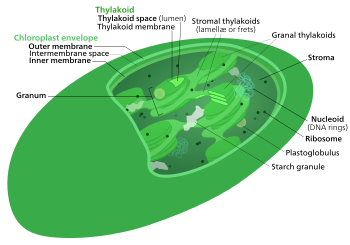The light-independent reactions of photosynthesis are chemical reactions that convert carbon dioxide and other compounds into glucose. These reactions occur in the stroma, the fluid-filled area of a chloroplast outside of the thylakoid membranes. These reactions take the products(ATP and NADPH)of light-dependent reactions and perform further chemical processes on them. There are three phases to the light-independent reactions, collectively called the Calvin cycle: carbon fixation, reduction reactions, and ribulose 1,5-bisphosphate (RuBP) regeneration.

Despite its name, this process occurs only when light is available. Plants do not carry out the Calvin cycle by night. They, instead, release sucrose into the phloem from their starch reserves. This process happens when light is available independent of the kind of photosynthesis (C3 carbon fixation, C4 carbon fixation, and Crassulacean Acid Metabolism); CAM plants store malic acid in their vacuoles every night and release it by day in order to make this process work.
No comments:
Post a Comment